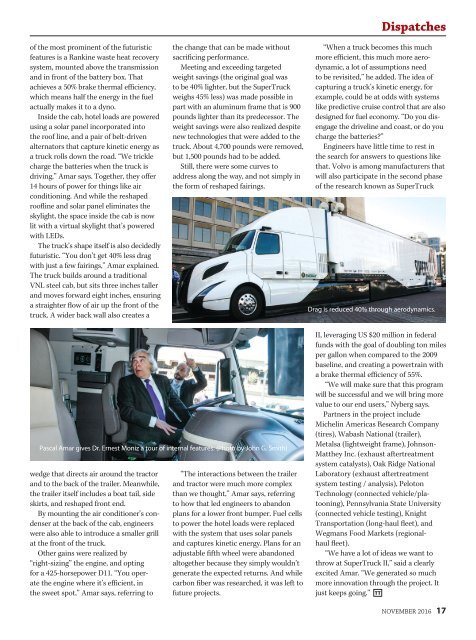DIGGING IN
2faRCNO
2faRCNO
Create successful ePaper yourself
Turn your PDF publications into a flip-book with our unique Google optimized e-Paper software.
Dispatches<br />
of the most prominent of the futuristic<br />
features is a Rankine waste heat recovery<br />
system, mounted above the transmission<br />
and in front of the battery box. That<br />
achieves a 50% brake thermal efficiency,<br />
which means half the energy in the fuel<br />
actually makes it to a dyno.<br />
Inside the cab, hotel loads are powered<br />
using a solar panel incorporated into<br />
the roof line, and a pair of belt-driven<br />
alternators that capture kinetic energy as<br />
a truck rolls down the road. “We trickle<br />
charge the batteries when the truck is<br />
driving,” Amar says. Together, they offer<br />
14 hours of power for things like air<br />
conditioning. And while the reshaped<br />
roofline and solar panel eliminates the<br />
skylight, the space inside the cab is now<br />
lit with a virtual skylight that’s powered<br />
with LEDs.<br />
The truck’s shape itself is also decidedly<br />
futuristic. “You don’t get 40% less drag<br />
with just a few fairings,” Amar explained.<br />
The truck builds around a traditional<br />
VNL steel cab, but sits three inches taller<br />
and moves forward eight inches, ensuring<br />
a straighter flow of air up the front of the<br />
truck. A wider back wall also creates a<br />
the change that can be made without<br />
sacrificing performance.<br />
Meeting and exceeding targeted<br />
weight savings (the original goal was<br />
to be 40% lighter, but the SuperTruck<br />
weighs 45% less) was made possible in<br />
part with an aluminum frame that is 900<br />
pounds lighter than its predecessor. The<br />
weight savings were also realized despite<br />
new technologies that were added to the<br />
truck. About 4,700 pounds were removed,<br />
but 1,500 pounds had to be added.<br />
Still, there were some curves to<br />
address along the way, and not simply in<br />
the form of reshaped fairings.<br />
“When a truck becomes this much<br />
more efficient, this much more aerodynamic,<br />
a lot of assumptions need<br />
to be revisited,” he added. The idea of<br />
capturing a truck’s kinetic energy, for<br />
example, could be at odds with systems<br />
like predictive cruise control that are also<br />
designed for fuel economy. “Do you disengage<br />
the driveline and coast, or do you<br />
charge the batteries?”<br />
Engineers have little time to rest in<br />
the search for answers to questions like<br />
that. Volvo is among manufacturers that<br />
will also participate in the second phase<br />
of the research known as SuperTruck<br />
Drag is reduced 40% through aerodynamics.<br />
Pascal Amar gives Dr. Ernest Moniz a tour of internal features. (Photo by John G. Smith)<br />
wedge that directs air around the tractor<br />
and to the back of the trailer. Meanwhile,<br />
the trailer itself includes a boat tail, side<br />
skirts, and reshaped front end.<br />
By mounting the air conditioner’s condenser<br />
at the back of the cab, engineers<br />
were also able to introduce a smaller grill<br />
at the front of the truck.<br />
Other gains were realized by<br />
“right- sizing” the engine, and opting<br />
for a 425-horsepower D11. “You operate<br />
the engine where it’s efficient, in<br />
the sweet spot,” Amar says, referring to<br />
“The interactions between the trailer<br />
and tractor were much more complex<br />
than we thought,” Amar says, referring<br />
to how that led engineers to abandon<br />
plans for a lower front bumper. Fuel cells<br />
to power the hotel loads were replaced<br />
with the system that uses solar panels<br />
and captures kinetic energy. Plans for an<br />
adjustable fifth wheel were abandoned<br />
altogether because they simply wouldn’t<br />
generate the expected returns. And while<br />
carbon fiber was researched, it was left to<br />
future projects.<br />
II, leveraging US $20 million in federal<br />
funds with the goal of doubling ton miles<br />
per gallon when compared to the 2009<br />
baseline, and creating a powertrain with<br />
a brake thermal efficiency of 55%.<br />
“We will make sure that this program<br />
will be successful and we will bring more<br />
value to our end users,” Nyberg says.<br />
Partners in the project include<br />
Michelin Americas Research Company<br />
(tires), Wabash National (trailer),<br />
Metalsa (lightweight frame), Johnson-<br />
Matthey Inc. (exhaust aftertreatment<br />
system catalysts), Oak Ridge National<br />
Laboratory (exhaust aftertreatment<br />
system testing / analysis), Peloton<br />
Technology (connected vehicle/platooning),<br />
Pennsylvania State University<br />
(connected vehicle testing), Knight<br />
Transportation (long-haul fleet), and<br />
Wegmans Food Markets (regionalhaul<br />
fleet).<br />
“We have a lot of ideas we want to<br />
throw at SuperTruck II,” said a clearly<br />
excited Amar. “We generated so much<br />
more innovation through the project. It<br />
just keeps going.” TT<br />
NOVEMBER 2016 17


